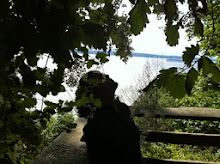Afterthoughts on four books read in the past year (or so). As always,
if you are looking for a review please look elsewhere. Posted below are some thoughts
that these books brought to the fore.
1
Moonwalking with Einstein:
The Art and Science of Remembering Everything by Joshua Foer
I read the American edition
of the book: The one with the delightful cover featuring a Sumo wrestler and a
dinosaur, among other things, placed on the different levels of a house (which
makes perfect sense when one has read the book). It was lent by a friend who
said, “You read it first. You’ll like it.” It was a gesture that is becoming
obsolete– the one where friends lend you their brand new unopened books, not
simply because they want you to read it first, but because they really like you
and that is their way of expressing it.
If you haven’t heard about
the book then it is clear that you and I don’t share the same planet (by which
I simply mean the same perspective and worldview and interests and so on). So
much has already been said about the book and Joshua Foer that I can’t think of
anything new to add. That this book is/will become a classic is never in doubt.
What is perhaps worth debating is whether being able to remember everything
(and never forget anything) is a desirable mental state. In fact, the book
dwells on this aspect too. We get to meet the most forgetful man in the world and
also the man who could never forget anything.
But what the book most
importantly demonstrates is the capacity of the human brain to learn things
that we categorize as ‘difficult’. A source of inspiration, a self-help book,
for all those who quiver in the presence of algebra or art.
2
The Facts of Winter by Paul
Poissel translated by Paul La Farge
Paul Poissel was not born in
1848. As a young man, he did not set out to become the greatest Turkish
architect in Paris. He did not fail to become the greatest Turkish architect in
Paris. He never became a poet, or invented puzzles for an illustrated magazine.
In 1904, he did not write this book, The Facts of Winter.*
Of course, Paul Poissel
doesn’t exist. Just like the vivid, evocative dreams of Parisians living in
1881, recorded in this book that he never wrote. Without giving away the
premise of the book, in case you haven’t read it, let me just say that this
book will teach you how to write a dream and/or how a book is written.
Which brings us to the
question: Where does memory end and imagination begin?
For me oranges are a fact of
winter. As the snow falls outside my window, even as I type these words, the
imagined smell of oranges brings to mind memories of sunny winter afternoons.
Which leads me to other winters, and other facts, and other dreams from those
other times.
*From the back cover of the
book.
3
Edgelands: Journey’s into
England’s True Wilderness by Paul Farley and Michael Symmons Roberts
People planning trips to
‘wildlife sanctuaries and parks’ often forget that wild creatures co-exist with
humans. And also that the sanctuaries aren’t truly wild but are intensively
managed by humans (but that is the subject of another post).
Most of the photographs that
I take are from the urban areas– the birds, flowers and trees are always a
short walk or bus/train ride away from my house. Most are found on my daily
commute. Wildlife and wilderness isn't elsewhere. But to understand that you’ll
need to re-examine the definition of the word ‘wilderness’. Two poets in a
beautifully written book, part childhood memory, and part exploration present
you a new perspective on it.
This book is about the
oft-neglected spaces– the landfill sites, gravel pits, motorways, business
parks, parking lots– the Edgelands, the spaces where the “veneer of
civilization” peels away and reveals the true wilderness that is neither ‘city
nor countryside’. It is also an exploration of our imagined and idealized
notions of wilderness (that we pick up from the books we read) and the
wilderness that is always there, close at hand. An issue close to my heart,
you’ll probably call it my work– same thing, different definitions.
4
The Selected Stories of
Mavis Gallant by Mavis Gallant
I began this post by talking
about books and friends. And book covers. I partly picked up this book for the
haunting cover photograph by Henri Cartier-Bresson. Also I consider Mavis
Gallant’s stories friendly: they are welcoming at the end of a long day, but
more importantly they always speak to me.
I
have written about Mavis Gallant elsewhere on this blog. But I keep come
back to Mavis Gallant because she writes about nomads and people in exile– not
just people living away from the place where they were born but people who are
disengaged and detached. People juggling memory, imagination and reality. At
times homesick but the home they pine for doesn’t exist, neither here nor in
the country that is considered their nationality (often a short form for their
identity).

























